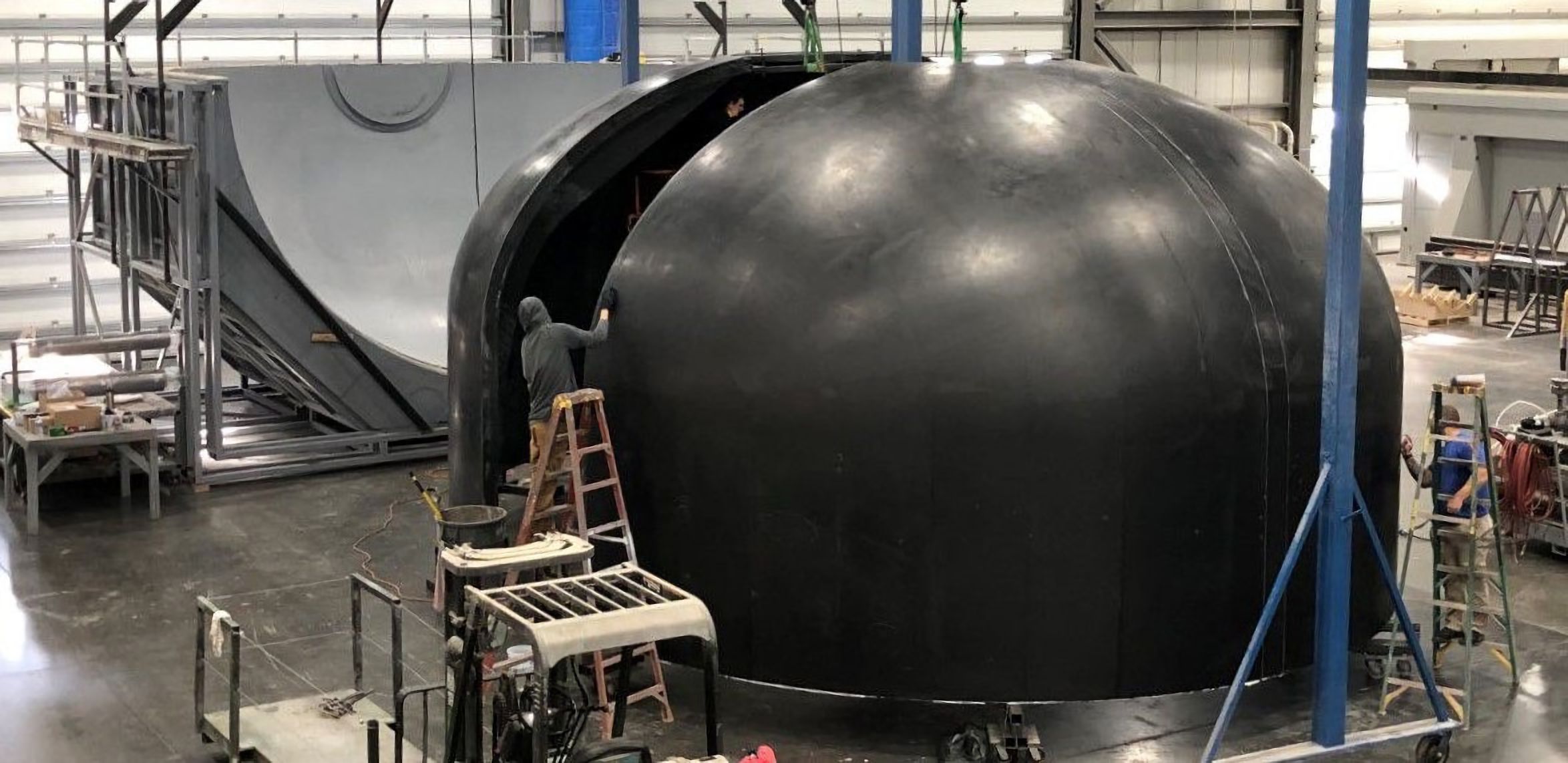

News
Rocket Lab assembling first reusable Neutron rocket hardware
Rocket Lab appears to have made significant progress since revealing the state of hardware development for its next-generation Neutron rocket in a September 2022 investor update.
At the time, the company shared photos of early work on prototypes of smaller Neutron structural elements, as well as progress building the giant molds that will be used to ‘lay up’ the rocket’s carbon fiber composite tanks and airframe. Rocket Lab also showed off acquisitions of some of the supersized manufacturing equipment that will be used to build the giant rocket, as well as the beginnings of a dedicated Neutron factory in Virginia.
Four months later, photos shared by CEO Peter Beck show that Rocket Lab has progressed to full-scale carbon fiber hardware manufacturing. In December 2022, Beck shared a photo of a full-size Neutron tank dome in the middle of production. A month later, Beck shared a photo of work on both halves of a Neutron booster tank dome. Measuring around seven meters (23 ft) wide, the latter component is already on track to become one of the largest carbon fiber structures ever prepared for a rocket once the halves are joined. And once two more halves are built and assembled, Rocket Lab could soon be ready to start testing full-scale Neutron tank hardware – a crucial milestone for any new rocket.
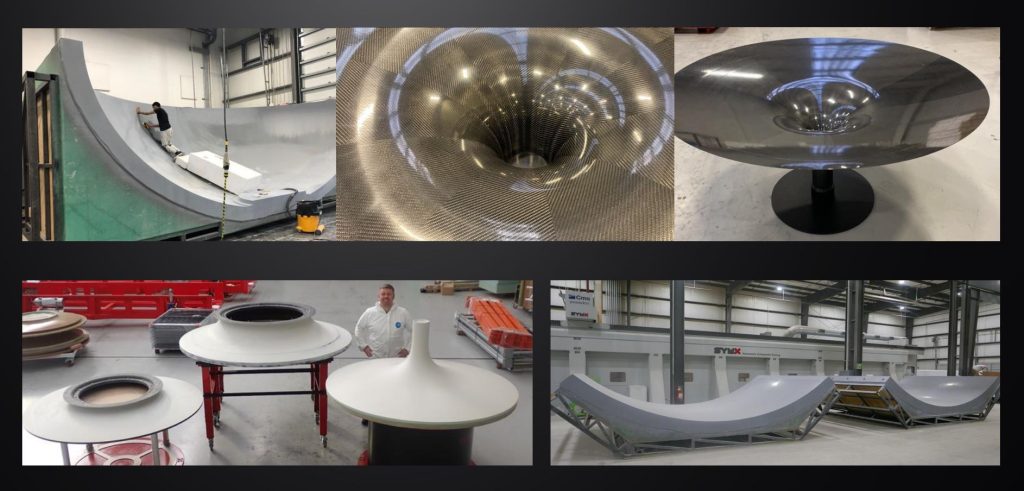
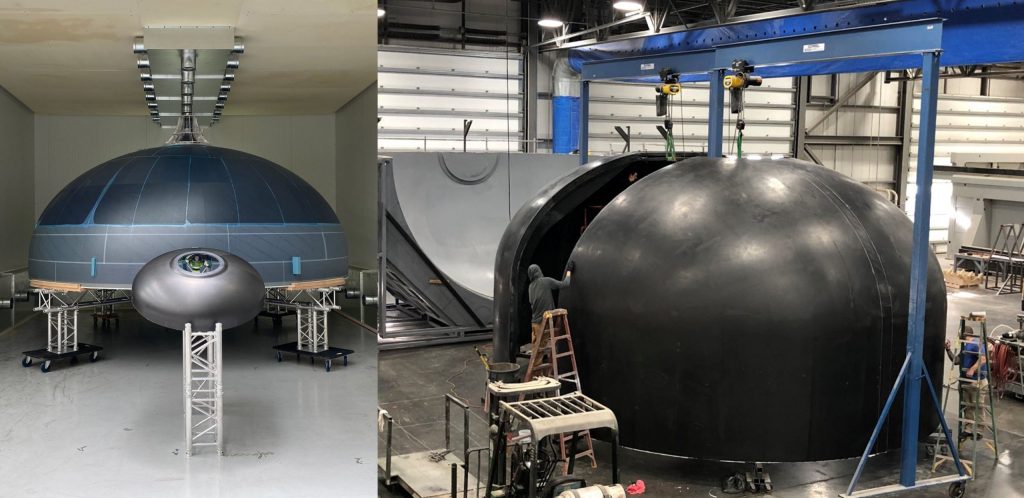
The update that's rolling out to the fleet makes full use of the front and rear steering travel to minimize turning circle. In this case a reduction of 1.6 feet just over the air— Wes (@wmorrill3) April 16, 2024
Announced in March 2021 and properly unveiled in December 2021, Neutron is a partially-reusable two-stage rocket designed to launch up to 15 tons to Low Earth Orbit (LEO) using liquid methane and oxygen propellant. Neutron measures 42.8 meters (140.4 ft) tall and up to seven meters (23 ft) wide. Its stout, ballistically-optimized design means that it’s simultaneously 40% shorter and up to 190% wider than SpaceX’s workhorse Falcon 9 rocket.
Design differences aside, Neutron is the first rocket that has been obviously designed as an answer to Falcon 9, which has become one of the most prolific, cost-effective, and routinely reusable rockets in the world over the last five or so years. Depending on how much Rocket Lab can sell Neutron for while still breaking even, Neutron has the potential to give Falcon 9 a serious run for its money – or at least force SpaceX to lower its prices. Like Falcon 9, Neutron will have a reusable booster, a reusable payload fairing, and an expendable upper stage. Its booster will also have nine (Archimedes) engines and the upper stage will be powered by one engine. At liftoff, Neutron will produce up to 674 tons (1.49M lbf) of thrust to Falcon 9’s 770 tons (1.7M lbf).
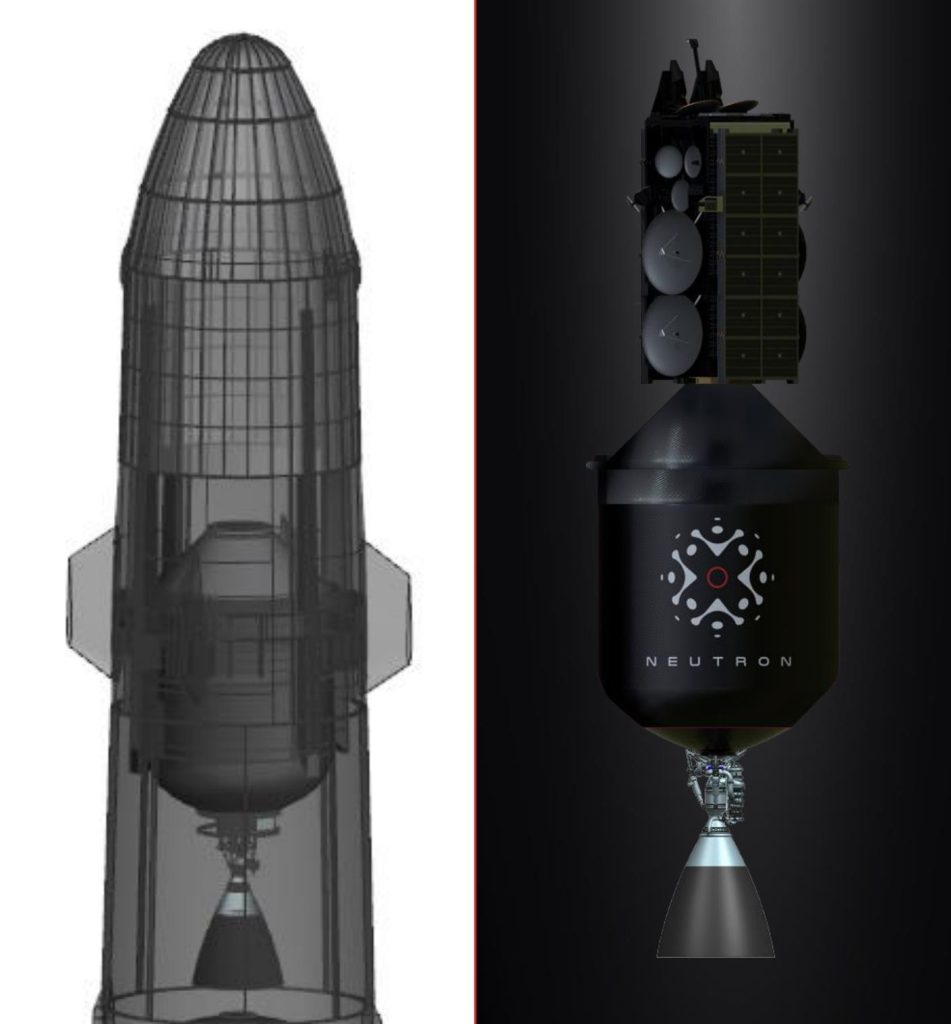
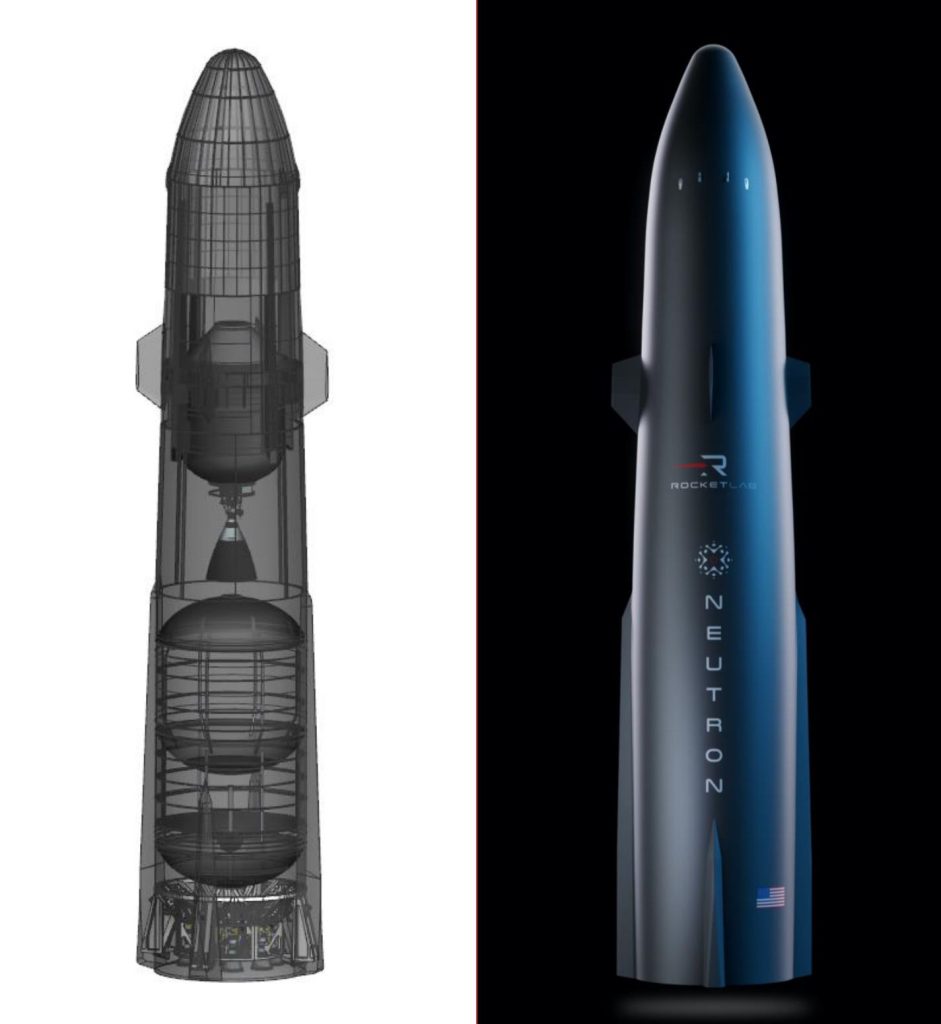
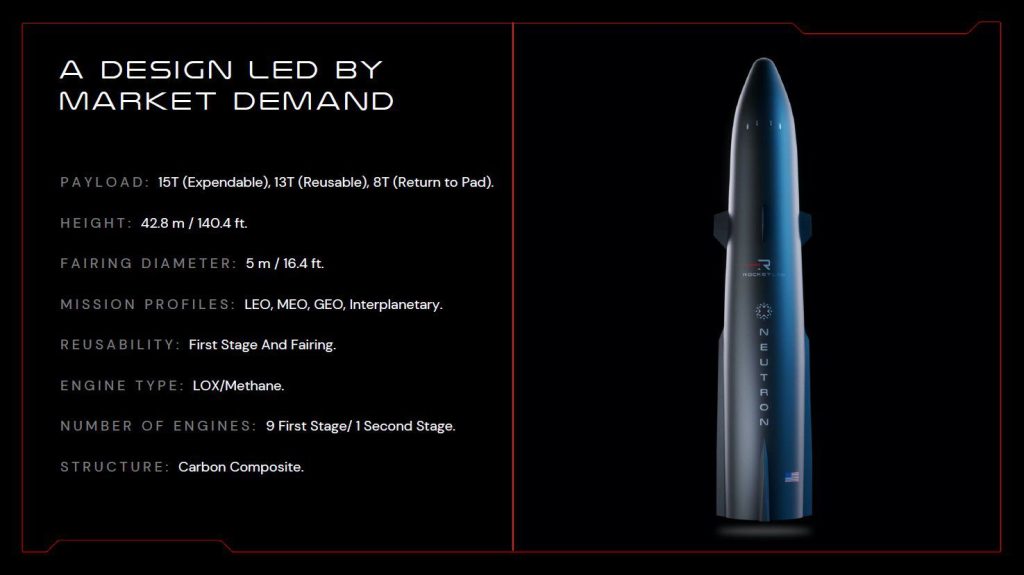
Unlike Falcon 9, Neutron’s similarly-sized reusable fairing is integral, meaning that it will stay permanently attached to the booster. But despite the added mass of the integral fairing and the rocket’s significantly shorter layout, Rocket Lab says that Neutron will be able to launch up to 13 tons (~28,700 lb) to LEO if the booster lands on a barge downrange. Using the same approach with a deployable fairing, Falcon 9 has launched up to 16.7 tons (~36,800 lb) to LEO. That 23% performance gap may seem significant, but the reality is that only SpaceX’s own Starlink and Dragon missions have ever needed Falcon 9 to launch more than 13 tons to orbit.
If Neutron can consistently launch ~25% less payload than Falcon 9 to all Earth and near-Earth orbits, virtually every commercial launch contract that’s currently a SpaceX shoo-in could be within reach of Rocket Lab within several years. The challenge, of course, is building Neutron and making sure the ambitious rocket and its clean-sheet Archimedes engine work as expected and can be reused as easily as Falcon 9.
The company is attempting to get there with its far smaller Electron vehicle, but Rocket Lab has never reused a rocket. And five and a half years after Electron’s debut, the company has never launched more than nine times in one year. SpaceX is about to reuse a Falcon booster for the 140th time and launched 61 times in 2022 – a lead that may prove almost impossible to close. There’s also the fact that the size gap between Rocket Lab’s rockets is so extreme that Neutron could likely launch a fully-fueled Electron into orbit.

But again, SpaceX serves as a demonstration that what Rocket Lab hopes to achieve is not impossible. SpaceX went directly from Falcon 1 (about twice as large as Electron) to Falcon 9 V1.0 (about 30% smaller than Neutron) after just two successful launches of the smaller rocket. Electron has successfully launched 29 times since May 2017 and Rocket Lab is already learning about reusability through the smaller rocket. The challenges facing Rocket Lab are huge, but Neutron still remains the most promising SpaceX competitor currently in development. Kicking off full-scale Neutron tank testing just 2-3 years after the rocket was revealed would only reiterate its strengths. Stay tuned to see how much Neutron progress Rocket Lab can make in 2023.

Elon Musk
Elon Musk’s X will start using a Tesla-like software update strategy
The initiative seems designed to accelerate updates to the social media platform, while maintaining maximum transparency.

Elon Musk’s social media platform X will adopt a Tesla-esque approach to software updates for its algorithm.
The initiative seems designed to accelerate updates to the social media platform, while maintaining maximum transparency.
X’s updates to its updates
As per Musk in a post on X, the social media company will be making a new algorithm to determine what organic and advertising posts are recommended to users. These updates would then be repeated every four weeks.
“We will make the new 𝕏 algorithm, including all code used to determine what organic and advertising posts are recommended to users, open source in 7 days. This will be repeated every 4 weeks, with comprehensive developer notes, to help you understand what changed,” Musk wrote in his post.
The initiative somewhat mirrors Tesla’s over-the-air update model, where vehicle software is regularly refined and pushed to users with detailed release notes. This should allow users to better understand the details of X’s every update and foster a healthy feedback loop for the social media platform.
xAI and X
X, formerly Twitter, has been acquired by Elon Musk’s artificial intelligence startup, xAI last year. Since then, xAI has seen a rapid rise in valuation. Following the company’s the company’s upsized $20 billion Series E funding round, estimates now suggest that xAI is worth tens about $230 to $235 billion. That’s several times larger than Tesla when Elon Musk received his controversial 2018 CEO Performance Award.
As per xAI, the Series E funding round attracted a diverse group of investors, including Valor Equity Partners, Stepstone Group, Fidelity Management & Research Company, Qatar Investment Authority, MGX, and Baron Capital Group, among others. Strategic partners NVIDIA and Cisco Investments also continued support for building the world’s largest GPU clusters.
News
Tesla FSD Supervised wins MotorTrend’s Best Driver Assistance Award
The decision marks a notable reversal for the publication from prior years, with judges citing major real-world improvements that pushed Tesla’s latest FSD software ahead of every competing ADAS system.

Tesla’s Full Self-Driving (Supervised) system has been named the best driver-assistance technology on the market, earning top honors at the 2026 MotorTrend Best Tech Awards.
The decision marks a notable reversal for the publication from prior years, with judges citing major real-world improvements that pushed Tesla’s latest FSD software ahead of every competing ADAS system. And it wasn’t even close.
MotorTrend reverses course
MotorTrend awarded Tesla FSD (Supervised) its 2026 Best Tech Driver Assistance title after extensive testing of the latest v14 software. The publication acknowledged that it had previously criticized earlier versions of FSD for erratic behavior and near-miss incidents, ultimately favoring rivals such as GM’s Super Cruise in earlier evaluations.
According to MotorTrend, the newest iteration of FSD resolved many of those shortcomings. Testers said v14 showed far smoother behavior in complex urban scenarios, including unprotected left turns, traffic circles, emergency vehicles, and dense city streets. While the system still requires constant driver supervision, judges concluded that no other advanced driver-assistance system currently matches its breadth of capability.
Unlike rival systems that rely on combinations of cameras, radar, lidar, and mapped highways, Tesla’s FSD operates using a camera-only approach and is capable of driving on city streets, rural roads, and freeways. MotorTrend stated that pure utility, the ability to handle nearly all road types, ultimately separated FSD from competitors like Ford BlueCruise, GM Super Cruise, and BMW’s Highway Assistant.
High cost and high capability
MotorTrend also addressed FSD’s pricing, which remains significantly higher than rival systems. Tesla currently charges $8,000 for a one-time purchase or $99 per month for a subscription, compared with far lower upfront and subscription costs from other automakers. The publication noted that the premium is justified given FSD’s unmatched scope and continuous software evolution.
Safety remained a central focus of the evaluation. While testers reported collision-free operation over thousands of miles, they noted ongoing concerns around FSD’s configurable driving modes, including options that allow aggressive driving and speeds beyond posted limits. MotorTrend emphasized that, like all Level 2 systems, FSD still depends on a fully attentive human driver at all times.
Despite those caveats, the publication concluded that Tesla’s rapid software progress fundamentally reshaped the competitive landscape. For drivers seeking the most capable hands-on driver-assistance system available today, MotorTrend concluded Tesla FSD (Supervised) now stands alone at the top.
News
Elon Musk’s Grokipedia surges to 5.6M articles, almost 79% of English Wikipedia
The explosive growth marks a major milestone for the AI-powered online encyclopedia, which was launched by Elon Musk’s xAI just months ago.

Elon Musk’s Grokipedia has grown to an impressive 5,615,201 articles as of today, closing in on 79% of the English Wikipedia’s current total of 7,119,376 articles.
The explosive growth marks a major milestone for the AI-powered online encyclopedia, which was launched by Elon Musk’s xAI just months ago. Needless to say, it would only be a matter of time before Grokipedia exceeds English Wikipedia in sheer volume.
Grokipedia’s rapid growth
xAI’s vision for Grokipedia emphasizes neutrality, while Grok’s reasoning capabilities allow for fast drafting and fact-checking. When Elon Musk announced the initiative in late September 2025, he noted that Grokipedia would be an improvement to Wikipedia because it would be designed to avoid bias.
At the time, Musk noted that Grokipedia “is a necessary step towards the xAI goal of understanding the Universe.”
Grokipedia was launched in late October, and while xAI was careful to list it only as Version 0.1 at the time, the online encyclopedia immediately earned praise. Wikipedia co-founder Larry Sanger highlighted the project’s innovative approach, noting how it leverages AI to fill knowledge gaps and enable rapid updates. Netizens also observed how Grokipedia tends to present articles in a more objective manner compared to Wikipedia, which is edited by humans.
Elon Musk’s ambitious plans
With 5,615,201 total articles, Grokipedia has now grown to almost 79% of English Wikipedia’s article base. This is incredibly quick, though Grokipedia remains text-only for now. xAI, for its part, has now updated the online encyclopedia’s iteration to v0.2.
Elon Musk has shared bold ideas for Grokipedia, including sending a record of the entire knowledge base to space as part of xAI’s mission to preserve and expand human understanding. At some point, Musk stated that Grokipedia will be renamed to Encyclopedia Galactica, and it will be sent to the cosmos.
“When Grokipedia is good enough (long way to go), we will change the name to Encyclopedia Galactica. It will be an open source distillation of all knowledge, including audio, images and video. Join xAI to help build the sci-fi version of the Library of Alexandria!” Musk wrote, adding in a later post that “Copies will be etched in stone and sent to the Moon, Mars and beyond. This time, it will not be lost.”








